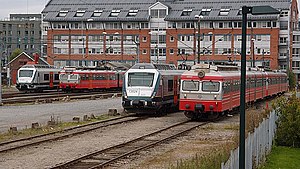
Back Trains de banlieue d'Oslo French Lokaltog i Oslo-området NB Kolej aglomeracyjna w Oslo Polish Oslos pendeltåg Swedish
| Oslo Commuter Rail | |||
|---|---|---|---|
 | |||
| Overview | |||
| Owner | Norwegian Railway Directorate | ||
| Locale | Eastern Norway | ||
| Transit type | Commuter rail | ||
| Number of lines | 8 | ||
| Number of stations | 128 | ||
| Annual ridership | 41.4 million (2019)[1] | ||
| Operation | |||
| Began operation | 1902 | ||
| Operator(s) | Vy Vy Gjøvikbanen | ||
| Number of vehicles | ? Class 69 ? Class 72 ? Class 74 51+ Class 75 | ||
| Technical | |||
| System length | 553 km (344 mi) | ||
| Track gauge | 1,435 mm (4 ft 8+1⁄2 in) standard gauge | ||
| Electrification | 15 kV 16.7 Hz AC | ||
| Top speed | 210 km/h (130 mph) | ||
| |||
Oslo Commuter Rail (Norwegian: Lokaltog Østlandet) is a commuter rail centered in Oslo, Norway, connecting the capital to six counties in Eastern Norway. The system is operated by Vy (formerly NSB) and its subsidiary Vy Gjøvikbanen, using Class 69 and Class 72 electric multiple units (EMU). The network spans eight routes and 128 stations, with Oslo Central Station (Oslo S) as the central hub. The trains run on 553 kilometers (344 mi) of electrified mainline railway owned by the Bane NOR. Deficits are financed by the Norwegian Ministry of Transport, although the network also has a ticketing cooperation with Ruter, the public transport authority in Oslo and Akershus. The network is the longest commuter rail network in the Nordic countries, and among top ten in Europe.
The commuter rail operates mainly within Greater Oslo and two of the lines only provide services within the urban area. Six of the lines span beyond the urban area, reaching the counties of Østfold, Hedmark, Oppland and Buskerud. The system is also an airport rail link to Oslo Airport, Gardermoen. West of Oslo, the system uses the Drammen, Asker, Spikkestad and Sørland lines, north of Oslo it uses the Gjøvik Line, east of Oslo it uses the Trunk, Gardermoen and Kongsvinger lines and south of Oslo it follows the Østfold and Eastern Østfold lines.
The system's predecessors date back to the opening of the Trunk Line in 1854. By 1902, all the routes used by the present commuter rail had been taken into service. Electrification started in 1922, and Class 62 EMUs were introduced in 1931, followed by Class 65 units in 1936 and Class 67 in 1953. Electrification was completed in 1963. In 1980, the Drammen Line was connected to the rest of the system and all trains started operating to the new Oslo S. The high-speed Gardermoen Line opened in 1998. In 2013, new Stadler FLIRT units were taken into traffic, and the Asker Line was completed just before. In 2022, the Follo Line was opened.
Traditionally, Oslo Commuter Rail were defined as train lines called "Lokaltog" (local trains) in Norwegian. Bun in 2022, a different definition was implemented. Only the two lines L1 and L2 are now defined as Lokaltog, and these go once per 15 minutes in each direction. All other lines in the network are now called "Regionaltog" (regional trains) and they have 30 or 60 minutes between departures and often take an hour from Oslo to the end station.
- ^ "Eventyrlig passasjervekst på jernbanen". banenor.no. 29 July 2020. Retrieved 24 December 2021.
© MMXXIII Rich X Search. We shall prevail. All rights reserved. Rich X Search
